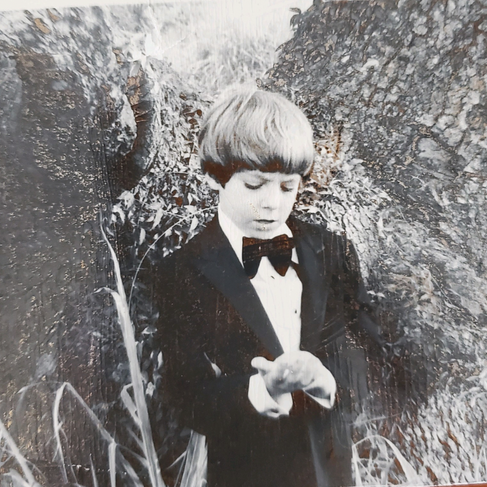
As of late in these posts I have been discussing my personal relationship with all sorts of art objects that happen to occupy a greater or lesser part of the furniture of our world. Of particular emphasis most recently has been those sorts of objects I am going to classify as popular or as entertainment. These taxonomies are sometimes necessary if only because they are a side effect of the enormous plurality and diversity of types of art. Among the reasons for my interest are an attempt to educate myself better concerning the culture of the 1980s and 90s: I was partly alienated from some commercial touchstones of those years.
Yet perhaps I will inevitably always return to the 1970s if only because all of the art I experienced during the era felt then and now not as something alien or separate but most familiar, even a part of me. Not many years ago our producer Laurie Strickland gave me for a birthday present this signed publicity still of Dick Van Patten from his famous Eight Is Enough period.

The show, although a work of fiction, was actually based on the life and book of Tom Braden, a liberal columnist and television commentator (he used to debate Pat Buchanan on television’s Crossfire) and the book concerned his family of six kids. Braden was also one of the earlier members of the Central Intelligence Agency (!) and most of his undercover work involved creating anti-soviet Left wing front organizations in both Europe and here, a practice with which I confess to having some sympathy. With the name Braden becoming Bradford, an hour long “dramedy” ( to use an anachronism from our current period) was born.
That show occupies an outsized part of my childhood in the late seventies because it was, alongside, Saturday Night Live, one of the few television programs that we watched as a family. All three of us were parked or perched in front of this profoundly ugly Maganvox or Trinitron, the type of design thoroughly embedded in the era of its making, when choices of popular art objects were few and everything was intended as some sort of mass market home appliance or piece of furniture.

It is most interesting, in a philosophic sense, to reflect on the cultural landscape I was attempting to survey and sometimes travel in those years. I realize only now that in large part I was similar in age to this Nicholas Bradford character as well similar to some of this character he played on the show.
I was also most curious about what it would have been like to live around so damned many people all of the time and under a single roof. Both of these matters concern the relationship between seeing ourselves and not seeing ourselves representative and fictional forms as those forms "look back" at us. My own family was in no way like this family on the show and they seemed exotic.
And though a boy, as beginning and developing heterosexual male, I was also attracted to the Bradford sisters.

When I looked up some internet definitions or explanations of Eight Is Enough one thing that was most noticeable was how much adults, especially parents, were captivated by this Adam Rich/Nicholas character on the show. This extent was so great that the fictional boy’s haircut became ubiquitous among boys in the era.
A personal photo here of myself getting ready for only of my many child magician performances reveals that I had this same haircut.
Adam Rich died last year at the age of 54. Like me he was a Libra and a fellow Gen Xer and was exactly a year younger than me. But there was just as much about us that had been very different.
I am not a determinist or an “inevitablist” in any way.But I do feel that we can take an inventory of what has happened in our lives and, as corny and perhaps overused as the following formulation can be, appreciate how the single particularity of a life "needs" to be as it has been if only to reflect the diversity of human life.
Later on when I was in my teens I loved being able to get my own haircuts on my own, yet continued to get that bowl cut because it seemed somehow easier or “familiar”.
An otherwise routine trip to the hair salon was a full immersion in the culture of the 1970s. I could not escape the fashions of the era - in this case the man who cut my hair had the fullest mane of hair and beard as well as this cheap, plastic, dead white (rather than the more sophisticated ecru) Panama hat that he would doggedly wear while working in the salon. This was in one of those by then ubiquitous shopping malls and the tagline for this place was “we make it natural.”
In a very real sense entering that mall was like entering the world itself or at least a world, and when one enters the world one is going to experience things essentially outside of oneself. One of the things the external and the internal share is that both have histories - they are intertwined with continual change - and both are represented through aesthetics.
Of course all of these things, - whether commercial television shows designed for a large audience, or the furniture out of which they were intended to beam, the presence of enormous amount of facial and head hair on males, or a bowl cut or a Dorothy Hamill hairdo - are essentially aesthetic decisions that we in turn tend to forget as being aesthetic. Rather, we look at them in moralistic and ideological ways, perhaps as time bound cultural habits that we must either continue or destroy. (Note I say destroy and not leave, abandon, forget).
One of the things I was developing, albeit in an undisciplined fashion (the discipline would come in adulthood) was a consciousness and theory about the innately diverse, multiple and at times, in Isaiah Berlin’s formulation, incommensurable purposes of art’s presence in the world.
The reason for this centrality of the awareness of difference in my relation with the world is that at the same time I was watching this at times moralistic, anodyne, innocuous even sentimental, family television series I was also encountering the wildness and irreverence of the SNL of Dan Ackroyd, John Belushi, Gilda Radner and company. It seemed utterly strange and mystifying to me that these two shows came out of this same machine called a television.
But difference becomes greater still when you consider that I was becoming interested at the same time in movies like Claudia Weil’s Girlfriends and a revival of Michelangelo Antonioni’s Blow-Up in movies theaters.
And in the same part of the 1970s I was regular exposed in the Summers to some of the most complex works of dramatic art that were being created, in New York City no less. I am talking about the plays of Harold Pinter, Sam Shepard, Landford Wilson, David Rabe and Charles Ludlum.
I was being exposed to creations whose emotional and intellectual range was as great as the sheer amount and volume of the work.
Immediately I saw this greatest of contrasts. These production on the stage were in every respect more interesting and meaningful to me than anything I had seen on television.
It was a matter of greatest confusion and even pain that I knew that this mass produced t.v. show was more pleasurable and enjoyable to so many more people than this rarefied kind of theatre in which I was being immersed and to which I was so attracted. And though I had the probably precocious awareness of how special and elevated these plays were, this was equally matched by my own frustration and misunderstanding over the many reasons for others’ preference for Eight Is Enough.
I am assuming that this is neither a case of insufficient exposure (education) or “intelligence”. As I said during an episode a year or so ago, it was my very own parents after all, one of whom had been a theatre producer, writer and director, who forced me to leave Pinter’s No Man’s Land and John Gielgud and Ralph Richardson during intermission. They felt violated and offended by the play’s break with some unspoken contract or agreement of what constitutes not only a “good” play but a any kind of play at all, with relatable or comprehensible “characters” at all.
As a boy I had so many questions about the panoramic scope of all of this.
Some of us have language we have used to articulate the distance travelled from when a popular artwork was so throughly constituted in a particular period to when it appears to be separated from us like the customs of beliefs of a faraway society. The word déclassé was once a popular one that expressed a more hierarchical relationship to culture. I sometimes might use the word anachronistic. A part of me has fondness for those artworks that do not “hold up” to the ravages of cultural change and passing time.
But the differences I was observing were not differences of entire social eras: they were differences within the same era. They were differences in people's appetites for comfort as well as excitement, for variety and curiosity as well as predictability. None of these appetites are ever equally distributed among people.
Isaiah Berlin has been most helpful in clarifying what we mean when even use the concept of a question: His remarks come from a televised interview with Bryan Magee in 1977.

Berlin goes on to explain a second type of question.

Isaiah Berlin’s three kinds of inquiry seems to me to have a metaphorical implication to some of the matters in aesthetic reception throughout any society that have fascinated me since childhood.
I felt I knew what made these artworks so different from one to the other. I experienced directly the emotional complexity of the Pinter play and others like it as well as the emotional simplicity of a television series.
But to articulate or even begin to comprehend this difference is to enter the third level in Berlin’s formulation. You could call it “none of the above.” It is neither empirical discovery of fact nor some preexisting, atemporal, rational system, but some other third level.
But to articulate or even begin to comprehend this difference is to enter the third level in Berlin’s formulation. You could call it “none of the above.” It is neither empirical discovery of fact nor some preexisting, atemporal, rational system, but some other third level. While you could say that we don’t have a method there Is the fact of our own consciousness and response to the world and that though there may be facts that make up the world these are not the final truth; they are more like maps.
Truth is really a stream, not discrete instances or things in space and time. I feel it is the world of art itself that gets closest to entering the stream.

Additional related info: link toBerlin and Magee archival interview:







